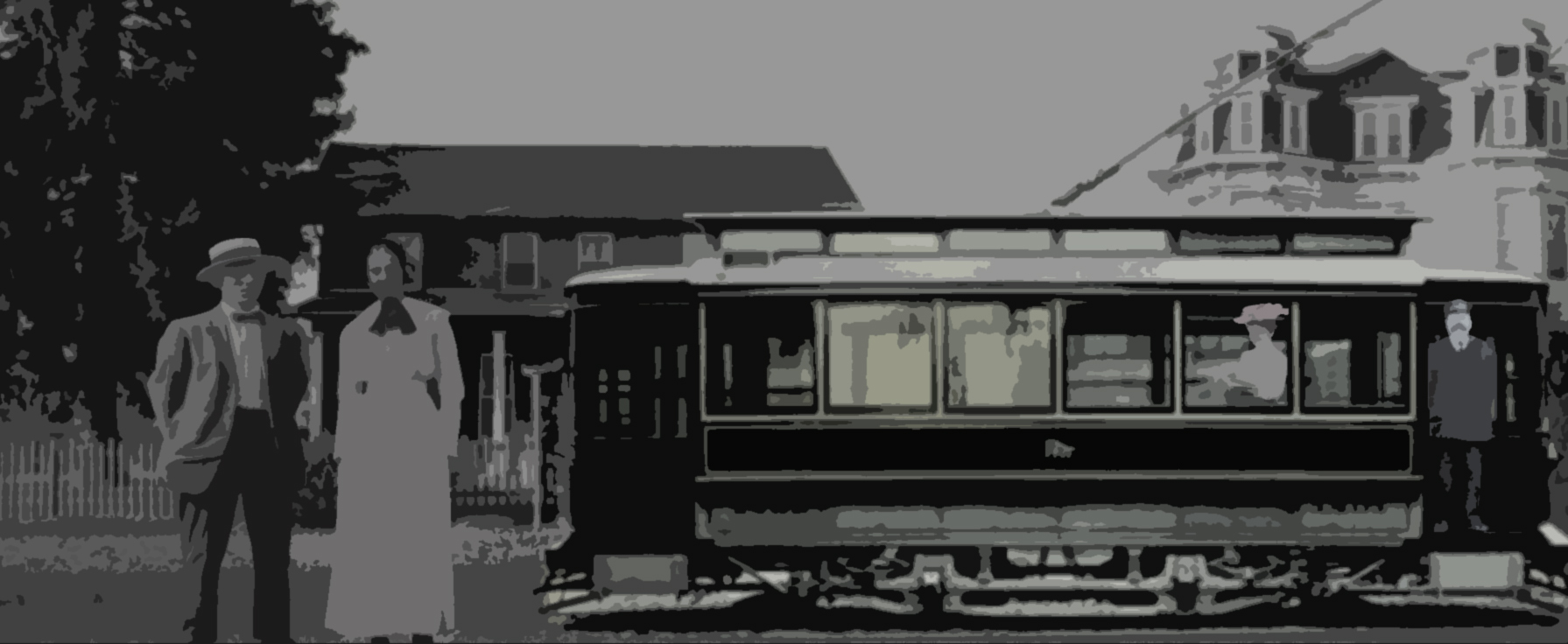Mennonites love history. It’s the 502th anniversary of the Protestant Reformation, All-Hallows Eve, and there’s high winds and a tornado watch, but tonight we’re enjoying a lecture on the streetcars of Lancaster County.

I’m at the Martindale Mennonite Fellowship Center, sitting in an audience of about three hundred and eighty people. Our speaker is eighty-three-year-old Herb Fisher. Mr. Fisher uses his version of a Powerpoint (Windows Photos, with verbal instructions for his helper to click the arrows) along with a strong, clear voice to guide us on a visual tour of the local trolley route from Lancaster City to the village of Terre Hill. His pointer, as you’ll note in the picture below, has a sharp, arrow-like point.

Just how interesting can a lecture on a defunct form of transportation be? Actually, it’s very interesting, especially to me, since the speaker is talking about a trolley route that would have passed right by my home. Had I lived a century ago, I could have waved to the passengers on the trolley from my bedroom window.
Mr. Fisher begins his lecture by talking about the predecessor to the trolley, the stagecoach. “Stagecoaches were named stagecoaches because they traveled in stages, stopping at one town, then the next, switching out horses at certain stops. Women would ask the local stagecoach driver to pick up items in the city for them.” Mr. Fisher even has a photo, from Southern Lancaster County, of a stagecoach with a bicycle strapped to the back. (Funny, I had always envisioned stagecoaches as belonging in the Wild West, not Lancaster County, PA.)
He shows us a few other photos of horse-drawn public transportation vehicles— an ambulance and a black coach that reads Home for the Homeless. “You think homelessness is a modern problem? Back then they picked them up.”
In January 1900, the Conestoga Traction Company was organized and began laying trolley tracks. At its peak, forty trolleys ran in Lancaster County, and twelve million people rode every year.
The actual “trolley” was the wheel used to get electric current from overhead wires. The streetcars the passengers rode in were called “cars”, as in “I took the cars to New Holland today.”
Transportation by streetcar was very popular, partly because the dirt roads were so terrible. Mud made the roads impassible for wagons and even automobiles, but the trolleys ran on smooth, steel rails. Riding the streetcars was also fast, going from Terre Hill to Lancaster City took only one hour and fifteen minutes (today by car it would be about thirty minutes.)
Mr. Fisher shows us numerous pictures of the trolley route in its heyday, and then the photos he took in the same location much more recently. Some of the old houses are still standing.
Herb says he started this project about ten years ago when he got bored. He and his wife went to “every corner of Lancaster County” to take present-day photos to match the historical images he was finding.
He shares humorous stories about tracing the trolley route— blazing through brush, being warned by a farmer about foxes, being ordered by a business owner to “leave the premises and do not take any pictures”.
When Herb stopped at one local farm, he was graciously welcomed inside by a white-haired Mennonite lady who happened to be celebrating her 100th birthday. She was more than happy to talk about the trolley route!
The streetcar route to Terre Hill ended in 1932, and the trolley service in Lancaster County ended in 1947. Eventually the tracks were removed. Today the houses on the south side of our street have larger front lawns than the houses on the north side, because of where the trolley tracks were laid.
When the meeting was over, I thought about how cool it would be to have a picture of our house with a streetcar. So with the help a few historic photos and some Photoshop filters, I came up with this artistic rendering of my house in the streetcar era.
I use Photoshop a lot at my job and while editing family snapshots. Obviously, realism, not creativity, is the goal in those instances. So it was nice to create something fake and stylized in Photoshop. I combined six photos to make my streetcar picture.
FYI, the other photos in this post have an “oil painting filter”.
Cheers! Til next time, Susan



I wanted to be there, but the “high winds and tornado watch” deterred me.
Did you know that your great-great uncle Aaron Rissler was a trolley conductor for the Conestoga Traction Co.?
And that your Grandpa Rissler bought a section of the trolley rail? I just found that out as I read your blog to the family. Randall said, “You aren’t going to run off with it, are you?” Apparently they use it in the shop for a weight. 🙂
I had no idea my great-great uncle was a trolley conductor! Apparently interest in trolleys runs in the blood! And, no, I didn’t know that there was a piece of history like that in the wood shop. I’ll have to check it out sometime.
Thanks for the interesting family history.